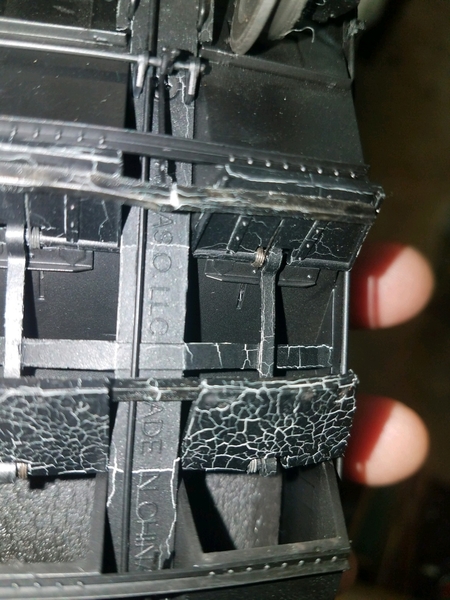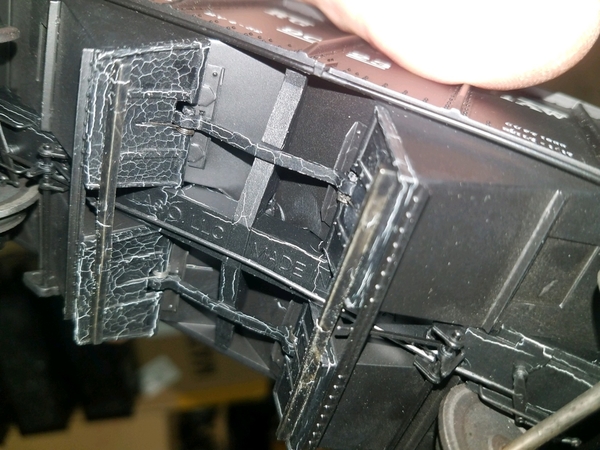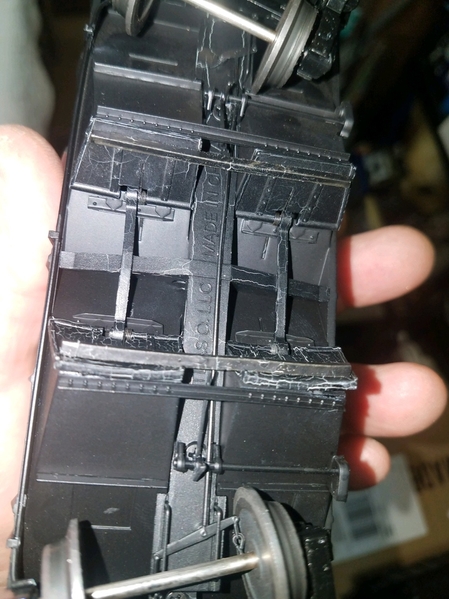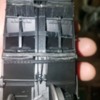Four years ago I picked up about 90 pair of new Athern trucks with IM wheels at Indy. They are extremely smooth rolling and long coasting. One of the most satisfying upgrades I have done.
Tom Tee posted:Four years ago I picked up about 90 pair of new Athern trucks with IM wheels at Indy. They are extremely smooth rolling and long coasting. One of the most satisfying upgrades I have done.
Hey Tom, are the Athearn trucks sprung?
Hi
On Ebay there is a MTH PRR P5 electric showing similar signs of zinc pest. He describes it as defective paint, but to me, it appears to be zinc pest.
https://www.ebay.com/itm/MTH-2...060778.c100290.m3507
Steve
Steam Guy posted:Hi
On Ebay there is a MTH PRR P5 electric showing similar signs of zinc pest. He describes it as defective paint, but to me, it appears to be zinc pest.
https://www.ebay.com/itm/MTH-2...060778.c100290.m3507
Steve
but he dose state that "it looks perfect from 5 feet away"
This is very scary stuff. Makes me nervous about buying without having it in hand to look over. Thanks for everyone bringing this up.
bluelinec4 posted:
Good Lord, those photos are absolutely disgusting. A grim reminder as to why I have not purchased any new or modern train item in quite some time. I just got tired of rolling the dice every time I made a new purchase. I know there are some who would have us believe that these zinc rot problems comprise only a small minority of what is produced overseas but I have been on this forum for twenty years and the number of times I have seen this problem referenced leads me to believe otherwise and this forum only represents a small fraction of this hobby.
I know many also state that the U.S. was confronted with this problem as well and overseas manufacturers should not be singled out for criticism. On the surface that is true but U.S. toy train manufacturers eventually solved their problem and rid themselves of this pest and that was 80 years ago. I am not aware of any zinc rot problems existing on any U.S. post-war production although I will accept the possibility that some did occur but I am not aware of it. Technology has progressed by leaps and bounds since 1939 and overseas manufacturers have had access to it. I think its about time we stopped making excuses for shoddy overseas production practices.
Sure, it may very well be true that the large overseas manufacturers rely on small sized sub-contractors for small piece items in the overall production process but the bottom line is they are responsible for the finished product as are the importers of this product within the U.S. Something should be done about it but nothing will be done about it because all we do as consumers is to continually purchase the same poorly produced items over and over again while the manufacturers and importers literally laugh all the way to the bank. The items they are making may look and sound pretty for a little while but virtually every hobbyist has it in their subconscious that it may not last very long.
Every time I see a thread like this it reminds me to look on one of my train shelves and scrutinize the scale JLC GGI I bought brand new about 10 years ago. Its the one in Brunswick Green with the cat's whiskers. It is rumored to be one of the few produced not suffering from zinc rot but every week or so I have to check on the side frames to see whether they are crumbling or not. So far so good but who knows what I will find next week. That is not why I joined the toy/model train hobby. I experience no enjoyment when I constantly fear an expensive item is going to go belly up through no fault of mine but rather through the inept production processes of overseas manufacturers. That's why I stopped buying modern train items. Some might want to take this into consideration the next occasion they contemplate making another $1,000 or $2,000 purchase.
Zinc pest is caused by contamination of the smelted alloy and I believe it also can be caused if the elements in the alloy aren't in the right ratio. With smelting, contaminants can be things like carbon (from the furnace used to cast it), dirt and dust, moisture, and even things (I am not kidding) like sweat. It is interesting, when Lionel made the 700e zinc alloy casting was still relatively new, and likely they had problems with quality control. With Chinese manufacturing, it is much like some Japanese car products in the 60's and 70's, they outsource production of certain parts to little mom and pop shops (in Japan, many of them were run by Koreans living there who sort of lived and worked in the shadows in some ways), and they often lack the facilities or the expertise to be able to keep the alloy pure. Not to mention that the way they work the quicker they produce it the more they make, it is very different than how a large supplier works (basically, these little firms don't have a contract for X units at Y cost and have no incentive to make more than X); they basically make as much as they can as fast as they can and get paid per item, so if they turn out 1000 they make more than 750 (it is on a per piece basis)...as a result they don't care about quality, and the person who outsourced it doesn't care, bc the cost of pieces that can't be used is made up for the fact they are getting the parts so cheaply that it doesn't hurt their profits. The person who contracted the parts likely inspects them and gets rid of the obvious problem ones, but the problem is a lot of them likely are marginal but that will turn up well after the unit is made and sold someplace.
Normally the supplier who subcontracted it out would be in trouble if units fail, but the way outsource manufacturing works in China, the companies getting the product built don't really stand to lose much if products fall apart, if they fail under warranty they will fix them, but the cost of doing that (or of losing customers over quality issues) is low compared to their profit margin per unit likely.
You have to keep in mind these products are not being produced on state of the art assembly lines, it is very different than the plants you see that put together solar panels or fabricate chips, the production of the parts and the units for these trains is more like piece work assembly in a sweat shop in the clothing industry 100 years ago (actually very similar, the little shop producing the zinc cast parts was sort of like the women, like my Grandmother, who did things like embroidery for the rag trade in NYC, they would do it at home and get paid per unit they stitched, other small shops would have people cutting out nothing but pockets to be used by the clothing manufacturer.
Mike D posted:As long as there are those among us that expect diecast products, we will have to deal with this issue. I don't understand the aversion to plastic. Plastic doesn't corrode, it's durable and it is cheaper to make. Sorry to hear about your issue. I think many of us have been bitten by the zinc pest from time to time.
Split shells from body-mounting screw holes in postwar diesels, cracked shells from minor falls, melted shells from electric malfunctions, inferior structural integrity, etc.
Aside from a pair of sideframes on an old Williams Train Master and a pair of trucks on a diecast MTH reefers, I have never had major problems with any of my diecast trains. I have had many more problems with plastic components.
Plastics came into being for toy trains because they were originally cheaper to make and easier on tooling. They also held find detail better. All of which has been offset by the fact that plastics are no longer inexpensive, diecast tooling is no longer expected to last through hundreds of thousands of uses, and hobbyists expected separately applied fine details instead of cast-on details.
Diecast isn’t just perceived to be better. It is superior.
It really depends on the plastic. Luran S, made by BASF and used by LGB for their outdoor trains from the '70s through the '90s, is exceptional. Durable, weatherproof, and UV-resistant. One of the issues though is the loss of heft. To make up for it, you would have to add weight inside the boiler. Unfortunately today, lead (Pb) is taboo to work with in industry. The manufacturers could sell the locos hollow and leave hobbyists to make weights on their own, it would probably save them a bundle on shipping costs too!
However, every time the question of plastic bodied steam locos comes up on the Forum, the consensus is that hobbyists want metal locos. Honestly with all of the failure-prone gimmicks manufacturers stuff in the boilers these days, I'm not sure there would be room to add a weight! Even the motor is almost an afterthought. ![]()
What chagrins me is that we had this problem pretty much solved by 1940, and now it's come back. I still wonder what it would cost to cast the parts in the U.S. Except for a few precision operations (such as quartering the driving wheels), leave painting and final assembly to the end hobbyist. I can solder a few wires and plug in electrical connectors. Color match problems: gone. Most quality control problems related to assembly: gone. Make gimmicky features like smoke, whistle steam, swinging bell, etc., OPTIONAL so the rest of us can just run our trains!
"Great performance without gimmicks, it just runs better because it's made right!"
"It's the gear ratio, Brian. It always has been the gear ratio."
I had this problem with the following cars:
8452 series Lackawanna;
8453 series New Haven;
8454 series NYC ( CCC&St.L);
8457 Series New York Central;
8461 Series New England Coal & Coke.
On all of these cars the center beam and the hopper doors disintegrated. Atlas provided free diecast replacement parts. Replacing the defective parts took quite a bit of effort. In the process some of the plastic detail parts were broken. I did not try to restore to like new because it was beyond my skill level.
Zinc pest is almost always due to high lead content. I'll look for the report I have, but as I recall, all it takes is 50ppm or more lead and you have trouble. Chemical analysis is required to determine lead content of a melt. You cannot tell just by looking at it. The small smelters in China do not have the where-with-all to get this testing done. So until the current brands move their production facilities out of China the problem is likely to continue.
My 2 cents.
Chris
LVHR
Honestly, if there is one thing I've learned from this and all the other threads, is never buy brand new diecast stuff and when you buy used, make sure you research it like crazy and stay away from affected models. Really sad too. I love that p5a engine that was posted above but I know now to stay very far away from them.
And to concentrate on buying plastic rolling stock even if it is plastic.
Jim R. posted:If the zinc alloy castings are manufactured properly, they are exceptionally durable. And the number of instances of zinc pest is minuscule in comparison to the overall production of zinc castings in our hobby from Asian production.
The problem in China is quality control involving small subcontractors for certain parts such as trucks, couplers and frames. Some of these model-train subcontractors operate out of garage-sized facilities that are far from state of the art. Some, not all, of these proprietors are either sloppy or indifferent in the production process for these castings.
The low-volume nature of these parts productions is what prompts the primary contractor to seek outside help.
Part of the answer would be for China to inspect and regulate small contractors. I suspect that’s not a government priority right now.
Also, for those who continually assail China for its quality production, I again have to point out that the zinc pest problem was also prevalent in toy and model train production in the prewar and postwar eras. Lionel’s 700E Hudson also suffered from zinc pest more than 80 years ago.
American manufacturers had to learn how to properly produce zinc castings, religiously avoiding impurities and performing best-practice standards. They eventually succeeded. China can, too, if it wants.
As for other options, well, ... . Let’s just say zinc alloys are used in so many products, usually of high quality, that I feel comfortable saying manufacturers rely on it as more useful than other choices. It’s their business, and I’m sure they have considered all the options.
Jim
Thanks. That was the most thought out response on this subject, I’ve seen in 10 years on forums. The idea my trains might fall apart still scares the crap out of me. I’ve only got a few cars where the couplers have snapped in odd places and that’s enough for me.
Marty
It’s a general comment on niche die-cast components of Chinese origin. Chinese quality control and customer service basically consists of “send another one and don’t pay the subcontractor”.
I had a carburettor body snap in half without warning, a while ago.
We are all aware of the zinc pest problems. And they do seem to be more and more of an occurrence. What about the use of aluminum for a casting materiel? I have a prewar O gauge AF Hudson with an aluminum cast tender. It is a great tender, has good heft and detailing. Has anyone on here knowledge to add about this alternative? Is it a viable alternative? Anyone know whether there is any history of a pest impurity of aluminum castings, of any type? Food for thought...….. Opinions...….
Jesse TCA 12-68275
No. Aluminum is too light, less than half the density of Zamak. Brass or bronze would be the logical choice and it won't ever crumble (although it can develop exterior corrosion in the presence of ammonia vapors.) However- brass locos sold by 3rd Rail and previous two-rail scale manufacturers are soldered together by hand out of sheet brass. This method is fine for low-volume models aimed at adults. It permits thinner walkways, etc., and importantly, avoids the high initial cost of tooling up a mold. Locos made this way wouldn't be durable enough for starter sets aimed at kids.
As the demographics of our hobby decline, the economics of die-casting for mass production are grim. Unless some future technology permits the molds to be rapidly and affordably created through automation, we may NEVER see another new single-purpose mold.* That's sad, because personally I just like the 'feel' of a thick casting better.
*Never say never... Unless I'm mistaken, there were no new die-cast locos developed for O gauge between the Lionel 'J' (in 1957) and the ill-fated Rock Island 4-8-4 (in 1987.) That Rock Island was a new boiler shell on a Berkshire chassis. But it was followed by the all-new Reading T1 in 1989, which opened the gates for all the subsequent new models from Korea and China. One can hope!!
Ted, when you speak of density, are you referring to mass integrity or simply the weight mass? Would not the hopefully elimination of any degradation of the product be worth the possible change in cast materiel ? Also, there are many aluminum alloys with record of long use without any difficulty, and do have sufficient mass. It is apparent the integrity of the casting materiel is overall the problem, and nobody disputes that. Along with use of aluminum, what other metal is readily available and proven for superior castings? Opinions...… I do realize some may believe to be a mute point, because it still involves a matter of QC. But, why not, can not, manufactures explore this route in seeking a resolution?
Jesse TCA 12-68275
This and other modern-era zinc pest discoveries should reinforce the importance to product marketers to be diligent in their oversight of their entire supply chain and the importance in having good relationships and communication with those manufacturing subcontractors. IMHO, you can not successfully have control or full knowledge of your products if you never set foot in the buildings where the product is produced.
I think the best example of a company in our hobby that follows this "boots on the ground" oversight practice is Scott Mann @sdmann of Sunset/3rd Rail/Golden Gate Depot. We see his product updates from the overseas factory when his products are in the production stage. I think it is safe to say that Scott's presence and experience provides quick response to any irregularity that he may see.












